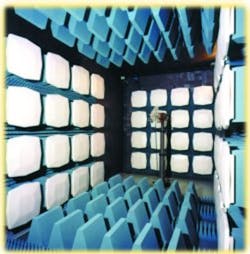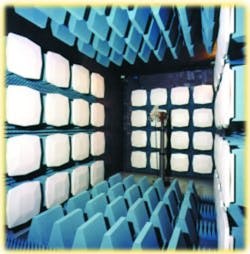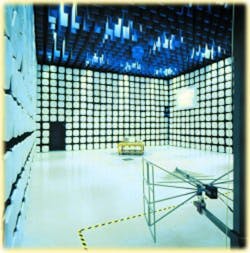With EMC regulations becoming more and more stringent, many product designers are trying to increase the odds that certification testing on their new products will be successful. One way to accomplish this is to procure a shielded room and the appropriate test equipment for precertification tests.
The choice of a shielded room for RF isolation involves some degree of compromise. The carefully constructed enclosure with no frills is the starting point in the selection process. The next level, the semi-anechoic chamber, uses absorbing material on the walls and ceiling, and the ultimate solution would be an expensive, fully anechoic room with complete RF isolation. Most product-development organizations can’t justify the cost of the latter structure, instead settling for one of the less expensive approaches.
What type of construction—laminated plywood, pan, welded, screened—is best for the room? The answer: each is optimum for certain applications and budgets.
Plywood Cell Room
“The most popular type of shielded enclosure is the plywood cell,” stated Bill Curran Jr., vice president of sales and marketing at Lindgren RF Enclosures. “A base structure of heavy-duty, ¾” plywood is laminated with two thin sheets of steel. This room satisfies the U.S. government’s shielding specifications of NSA 65-6, CID 09-12, and NSA 89-01, and the low cost is a major factor in its broad appeal.”
The construction is especially attractive if you want to add ferrite tile and absorption material inside to make a semi-anechoic chamber. Also, when some isolation from audible noise is needed, the structure has special applicability.
Pan-Shielded Construction
The modular pan structure is made of single-skin, 2-mm galvanized steel pieces, each turned up at the edges to resemble a large powder-painted baking pan. The turned-up edges of the pans are bolted together, and no welding is required. The resulting structure has good shielding performance from 10 MHz to 20 GHz.
Pans can be bolted on the inside or outside of the room. Inside flanges provide a smooth outer surface and a convenient way to install absorbent sheets. Outside flanges supply a smooth inside surface for high-voltage or reverberation applications. A room can be disassembled and reassembled many times with no degradation in performance.
DEI Enclosure
The modular, double electrically isolated (DEI) structure has two shielding membranes electrically isolated from each other except at a common-point ground. Panels can be factory tested for shielding effectiveness and generally exhibit 120 dB for frequencies up to 1 GHz. This structure is about 30% lighter than the popular plywood assembly.
A Welded Assembly
For the most demanding shielding requirements, the welded enclosure provides the most effective and reliable solution. It also is the most expensive and does not lend itself to relocation. Shielding effectiveness can be 120 dB to 40 GHz and 100 dB to almost 100 GHz. Very low frequencies, even down to 100 Hz, are shielded with the welded enclosure.
This enclosure is suited to areas and applications where temperature and humidity are not controlled. It meets the shielding requirements of NSA 65-5 and provides excellent physical security.
Don’t Forget the Door
Since it is the biggest opening, the door is a crucial and challenging element in the design of the shielding enclosure, according to Glen Watkins, director of marketing at ETS-Lindgren. “A shielded room with no door would be useless, but a room with an inadequate door can give a false sense of security. Especially frustrating is the door that seals properly on the new enclosure but loses its effectiveness as a result of wear,” he explained.
Since the door of a shielded room is more than a personnel passageway, manually operated sliding, semiautomatic swing, and fully automatic sliding configurations are most commonly used, the selection dictated by the application of the enclosure. For instance, if the room will accommodate a forklift, the door must be large enough to allow access. In addition, the threshold must be strong enough to bear all the expected loads without becoming distorted and potentially leaking RF.
Among the choices is a fully automated sliding door and movable ramp assembly developed by the TDK Group. “Two synchronized stepping motors provide smooth movement of the door, and a zero-force clamping mechanism seals the opening without distorting the shielded structure,” said Rob Hoffman, marketing manager at TDK RF Solutions, formerly EMC Automation. “Coincident with opening and closing, the ramp automatically raises and lowers, providing EMI sealing for the vulnerable base plate.”
A swing door designed by Euroshield and its United States affiliate, ETS-Lindgren, features a special hinge that allows a door-edge leaf to break the seal with a parallel movement before the door swings open. “This protects the beryllium-copper finger stock from breakage,” said Mr. Watkins of ETS-Lindgren, “yet uses the maximum shielding capability of the fingers when the door is shut.”
An EMC Test Configuration
An EMCO BiConLog™ Receiving Antenna is directed at the UUT as the operator conducts the test. An LCD projector housed in an RF shielded enclosure displays readings from test instrumentation in the control room, allowing an engineer to conduct a complete test without leaving the room.
Some Unique Applications
Even though the typical shielding application may be rather straightforward, manufacturers point to the unusual rooms with pride. Some of the examples never will be duplicated, but they illustrate the versatility of shielding applications.
Geodesic Dome
A four-frequency, self-supporting geodesic dome designed and constructed by Lindgren RF Enclosures is a 30¢-dia structure featuring 160 triangular shielded panels. It allows the user to generate RF at the focal point and make equidistant signal-strength measurements from near the skin of the dome.
Triangular Structure
Shielded rooms aren’t always rectangular or circular. Sandia National Laboratories has a triangular DEI structure for a special application.
Public Safety Facility
One of the challenging installations for a shielded enclosure is the public safety building in San Antonio, TX. This structure, carefully shielded to prevent unwanted radiations and guard against susceptibility to external signals, is more than 600¢ above ground atop the Tower of Americas.
Mining Applications
The Fermi Laboratory at the University of Minnesota uses a stainless steel plywood-cell shielded enclosure in a Sudan mine. This structure is 2,340¢ below the earth’s surface and 689¢ below sea level.
Finland has an underground room installed in a dark, humid cave. The monstrous installation, about the size of a football stadium, provides suitable RF shielding in an unfriendly environment.
Return to EE Home Page
Published by EE-Evaluation Engineering
All contents © 2001 Nelson Publishing Inc.
No reprint, distribution, or reuse in any medium is permitted
without the express written consent of the publisher.
September 2001


